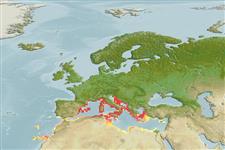Environment: milieu / climate zone / depth range / distribution range
Ecologia
marino demersale; distribuzione batimetrica 5 - 80 m (Ref. 4696), usually 5 - 30 m (Ref. 27115). Subtropical; 15°C - 20°C (Ref. 27115); 45°N - 27°N, 19°W - 36°E
Eastern Atlantic: northern Spain to Madeira and the Canary Islands; also in the Mediterranean.
Size / Peso / Age
Maturity: Lm ? range ? - ? cm
Max length : 10.0 cm TL maschio/sesso non determinato; (Ref. 4696)
Short description
Chiavi di identificazione | Morfologia | Morfometria
Spine dorsali (totale) : 7; Raggi dorsali molli (totale) : 14; Spine anali: 1; Raggi anali molli: 13. Distinguished by having the following characteristics: Reduced suckers (Ref. 92840).
Occurs in deeper inshore waters; over rocky substrates with algae and gorgonians (Ref. 4696). Abundant populations on coasts with steep bedrock. A shy species and difficult to collect due to long flight distances and hiding in deep clefts (Ref. 87880). Macrobenthos feeder on hard substrates ingest also shelled organisms like molluscs and echinoderms (Ref. 92840).
Life cycle and mating behavior
Maturities | Riproduzione | Spawnings | Egg(s) | Fecundities | Larve
Miller, P.J., 1986. Gobiidae. p. 1019-1085. In P.J.P. Whitehead, M.-L. Bauchot, J.-C. Hureau, J. Nielsen and E. Tortonese (eds.) Fishes of the North-eastern Atlantic and the Mediterranean. Volume 3. UNESCO, Paris. (Ref. 4696)
IUCN Red List Status (Ref. 130435)
Threat to humans
Harmless
Human uses
Pesca: commerciale; Acquario: Commerciale
Strumenti
Special reports
Download XML
Fonti Internet
Estimates based on models
Preferred temperature (Ref.
123201): 15.6 - 19.4, mean 18.1 °C (based on 68 cells).
Phylogenetic diversity index (Ref.
82804): PD
50 = 0.5000 [Uniqueness, from 0.5 = low to 2.0 = high].
Bayesian length-weight: a=0.01023 (0.00477 - 0.02194), b=3.02 (2.84 - 3.20), in cm total length, based on LWR estimates for this (Sub)family-body shape (Ref.
93245).
Trophic level (Ref.
69278): 3.0 ±0.35 se; based on food items.
Resilienza (Ref.
120179): Alto, tempo minimo di raddoppiamento della popolazione meno di 15 mesi (Preliminary K or Fecundity.).
Fishing Vulnerability (Ref.
59153): Low vulnerability (10 of 100).
